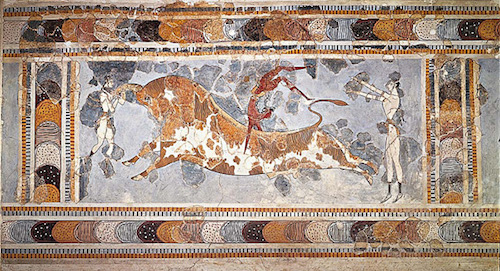In the Palaeolithic man killed animals to feed on their flesh and protected themselves from the cold with their skins. One of these animals was a wild ox, the Urus or Bos Primigenius, 6 foot tall and endowed with big horns. There are cave paintings of this time that represent men hunting bulls.
In the Neolithic period, men stop being nomads to settle and become farmers and ranchers. At this time rituals were already held in which bulls were sacrificed.
In the year 2000 a.c. The Cretans celebrated fertility rituals with brave bulls. Young men and young girls confronted the bull waiting for its charge, and at the last moment,, leaning on the animal’s horns, jumped over it landing on his back or on the ground. These rituals ended with the killing of the bull by breaking its neck or stabbing it . this ritual is usually named Bull-Leaping (taurokathapsia, from Greek ταυροκαθάψια) and cosists of an acrobatic leap over a bull; when the leaper grasps the bull’s horns, the bull will violently jerk his neck upwards giving the leaper the time to perform somersaults and other acrobatic tricks or stunts.
Bull-leaping is still practiced in the south west of France, where it is traditionally known as the course landaise (although usually cows are used instead of bulls. These cows are the female stock of the fighting bulls bred for the corrida in Spain. However once a year bulls are used, instead of cows, in the Festival of Art and Courage). The town of Mont-de-Marsan in Gascony is renowned for its fine sauteurs or “leapers” and écarteurs (“dodgers”) dressed in brocaded waistcoats. They compete in teams, attempting to use their wide repertoire of skillful evasions and acrobatic leaps to avoid the cow’s charges.

Bull-Leaping
Responder
